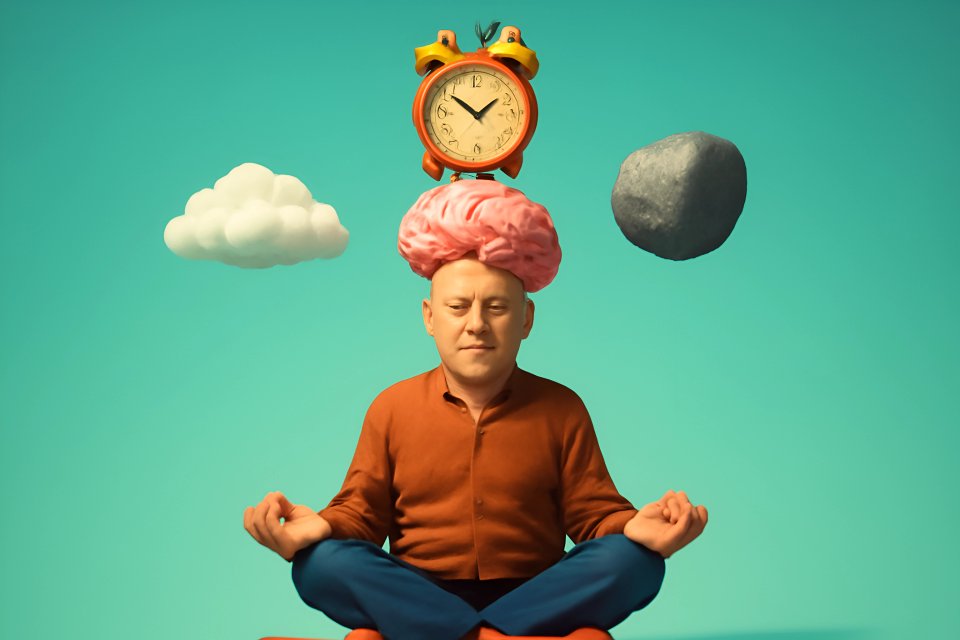
Ever walk into a room and forget why you're there? Or struggle to focus on a good book, your mind drifting away after just a few sentences? You are not alone. As we age, keeping our minds sharp is just as vital as keeping our bodies strong, a core part of our security and independence.
But what if one of the most powerful tools to protect your cognitive edge wasn't in a pill bottle or a complicated brain-training app? What if it was already with you, right now, waiting to be used? The secret is your breath, and it holds the key to unlocking a calmer, clearer, and more focused mind.
Most of us know that a few deep breaths can calm us down. But we're not talking about the basics today. This guide will take you beyond simple sighs of relief, introducing you to advanced—but completely achievable—breathing exercises. These specific techniques are backed by science and designed to directly target and enhance cognitive functions like focus, memory, and mental clarity for those of us navigating life over fifty.
The Powerful Link: How Your Breath Rewires Your Brain for Better Focus
It might sound too simple to be true, but the connection between your breath and your brain is profound and scientifically validated. When you intentionally control your breathing, you are actively changing your brain's chemistry and function for the better. It’s a direct line of communication to the command center of your body.
First, let's talk about fuel. Your brain, despite being only about 2% of your body weight, consumes a whopping 20% of your body's oxygen. Controlled, deep breathing increases the oxygen supply to your brain, literally fueling its performance. As explained in a 2025 article from Lonestar Neurology, this enhanced oxygen delivery directly supports cognitive processes like concentration and memory.
But it goes deeper than just oxygen. Mindful breathing is your secret weapon for calming your entire nervous system. Deep, slow breaths activate the vagus nerve, shifting your body out of the frantic "fight or flight" state and into the calm "rest and digest" parasympathetic state. This process reduces the flood of stress hormones like cortisol, which are notorious for impairing memory and clouding judgment. A 2023 review in the NCBI journal confirmed that regulated breathing practices enhance this parasympathetic activity, creating a powerful buffer against the cognitive drain of daily stress.
Moving Beyond the Basics: What Makes a Breathing Exercise "Advanced"?
You've likely heard of belly breathing, the foundational practice of drawing breath deep into your diaphragm. That's an excellent starting point, and if you need a refresher, our guide on deep breathing and meditation techniques offers a great overview. But to truly sharpen your cognitive function, it's time to add more sophisticated tools to your wellness toolkit.
So, what makes a breathing exercise "advanced"? It isn't about difficulty or physical strain. Instead, it's about structure and intention. Advanced techniques move beyond simple deep breaths and incorporate specific, deliberate patterns to achieve targeted results. These patterns often involve one or more of the following elements:
- Specific Ratios: Inhaling, holding your breath, and exhaling for precise, measured counts.
- Breath Retention (Kumbhaka): Intentionally and gently pausing with lungs full of air or empty of air.
- Alternating Nostrils (Nadi Shodhana): Directing the flow of breath through one nostril at a time to balance the brain.
Don't let the names intimidate you. These are time-tested practices that are safe, accessible, and can be easily modified to fit your comfort level. The goal is never to strain, but to gently guide your breath and, in doing so, guide your mind toward a state of peak performance and calm.
Your Toolkit: 3 Advanced Breathing Exercises to Sharpen Your Mind
Ready to take control? Here are three powerful, structured breathing exercises designed to boost your brainpower. Find a comfortable seat, relax your shoulders, and let's begin.
1. Box Breathing (Sama Vritti) for Unshakeable Focus
This technique is a favorite of Navy SEALs, athletes, and executives for a reason: it works. Box Breathing is your go-to practice for building unshakeable focus and calming anxiety before any mentally demanding task. Research shows that even brief mindfulness exercises can temporarily enhance cognitive functions like sustained attention, and this is the perfect tool for the job.
Here’s how to do it:
- Sit comfortably in a chair, with your feet flat on the floor and your back straight.
- Gently exhale all the air from your lungs through your mouth.
- Inhale slowly and deeply through your nose to a silent count of 4.
- Hold your breath, keeping your lungs full, for a count of 4.
- Exhale slowly and completely through your mouth or nose for a count of 4.
- Hold your breath, keeping your lungs empty, for a count of 4.
- This completes one "box." Repeat the cycle for 5-10 rounds, or about 2-3 minutes.
FitOverFifty Tip: If a 4-count feels too long at first, start with a 3-count. The goal is a comfortable, even rhythm, not strain. To help you stay on track, you can trace a square in the air with your finger as you breathe: trace up for the inhale, across for the hold, down for the exhale, and across for the final hold.
2. 4-7-8 Breathing for Better Memory and Restful Sleep
Developed by Dr. Andrew Weil, this technique is a natural tranquilizer for the nervous system. It's incredibly effective for reducing anxiety and preparing the brain for deep, restorative sleep—which is absolutely critical for memory consolidation. If you want to wake up feeling refreshed and mentally sharp, make this a part of your nightly routine, and explore our other mindful habits for better sleep to complete your wind-down.
Here are the steps:
- Sit or lie down in a comfortable position. Place the tip of your tongue against the ridge of tissue just behind your upper front teeth, and keep it there throughout the entire exercise.
- Exhale completely through your mouth, making a gentle "whoosh" sound.
- Close your mouth and inhale quietly through your nose to a mental count of 4.
- Hold your breath for a count of 7.
- Exhale completely through your mouth, making that "whoosh" sound again, for a count of 8.
- This is one full breath. Inhale again and repeat the cycle three more times for a total of four breaths.
FitOverFifty Tip: The most crucial part of this exercise is the long, 8-second exhale. It’s what powerfully activates the parasympathetic nervous system. Focus on making it slow, steady, and complete. If you're struggling with sleep, our guide on advanced tips for overcoming insomnia offers more powerful strategies.
3. Alternate Nostril Breathing (Nadi Shodhana) for Mental Clarity & Balance
This classic yogic breathing practice is designed to bring balance to the entire system. It is said to harmonize the left and right hemispheres of the brain, making it a fantastic tool for clearing away "brain fog" and enhancing overall mental clarity. Studies show that slow breathing exercises can improve executive function and emotional regulation, and this technique is a perfect example of that principle in action.
Follow these instructions:
- Sit in a comfortable, upright position. Rest your left hand on your lap and bring your right hand up to your nose.
- Gently close your right nostril with your right thumb. Inhale slowly and deeply through your left nostril.
- Close your left nostril with your right ring finger, so both nostrils are briefly held closed. Hold the breath for a moment.
- Release your thumb and exhale slowly and completely through your right nostril.
- Now, inhale through that same right nostril.
- Hold both nostrils closed again with your thumb and ring finger.
- Release your ring finger and exhale fully through the left nostril.
- This completes one full round. Continue for 5-10 rounds, allowing your mind to settle.
FitOverFifty Tip: If holding your arm up becomes tiring, rest your elbow on a pillow or the arm of your chair for support. The movement of your fingers should be gentle and fluid, not forceful. This practice is about ease, not effort.
How to Make It a Habit: Weaving Mindful Breathing into Your Day
The true power of these exercises is unlocked through consistency. You don't need an hour a day; just a few minutes, woven into your existing routine, can make a world of difference. Building these into your life is simple when you anchor them to things you already do.
Think of it as a simple schedule for your mind. You can use these techniques to bookend your day and navigate its challenges. This is how you build powerful mindful daily routines for increased energy and mental stamina.
Here is a sample daily plan to get you started:
| Time of Day | Recommended Exercise | Duration | Benefit |
|---|---|---|---|
| Morning | Box Breathing | 5 Minutes | Start the day with calm focus. |
| Afternoon | Alternate Nostril Breathing | 3 Minutes | Beat the midday slump and brain fog. |
| Evening | 4-7-8 Breathing | 2 Minutes | Wind down for restorative sleep. |
Real Stories from the FitOverFifty Community
Don't just take our word for it. Here’s how members of our community are using these exact techniques to reclaim their mental sharpness and feel more in control. These aren't just exercises; they are life-changing habits.
"I started doing Box Breathing before my weekly card game, and my concentration has improved dramatically. I used to get distracted easily, but now I feel sharper and more in the zone. My friends have even noticed!"
"I used to get so flustered when I couldn't remember a name or a word. It was stressful. Now, I take a moment for Alternate Nostril Breathing. It calms me down instantly, and often, the thought comes back to me without all that anxiety."
Conclusion
Your breath is not just automatic; it is a powerful, portable, and profoundly effective tool that is always available to you. It costs nothing, requires no equipment, and can be practiced anywhere. You have the ability to directly influence your cognitive function, reduce your stress, and improve your overall well-being, all by mastering the rhythm of your own breath.
Mastering your breath is a true act of self-care and a declaration of your commitment to healthy aging. Start small, stay consistent, and embrace this simple practice to keep your mind as active and vibrant as your body. You have the power to cultivate a sharper, calmer, and more resilient mind, one conscious breath at a time.
Which exercise are you most excited to try first? Share your thoughts and questions in the comments below—we'd love to hear from you!
Frequently Asked Questions (FAQ)
Q: How long until I notice cognitive benefits?
A: You'll likely feel calmer and more focused immediately after a session. More significant cognitive benefits, like improved memory and sustained focus, build with consistent daily practice over several weeks. Consistency is more important than duration.
Q: Can I do these if I have high blood pressure or a respiratory condition?
A: Always consult with your doctor before starting any new health practice, including breathing exercises. Never hold your breath if it causes discomfort, dizziness, or strain. The key is gentle, mindful practice that feels good for your body.
Q: What's the difference between this and regular meditation?
A: Think of these breathing exercises as a form of active meditation. While some meditation involves passively observing the breath, these techniques have you actively guiding it to achieve a specific outcome (like focus or relaxation). This makes them a great and accessible entry point into the world of mindfulness and meditation for stress relief.
















